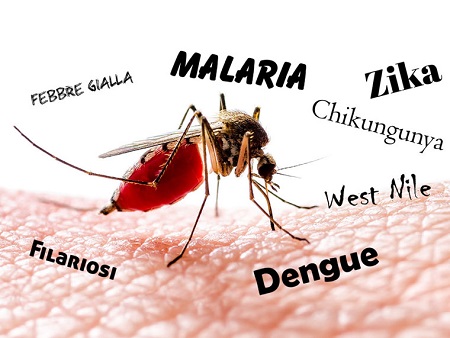IZS - Istituto Zooprofilattico Sperimentale Abruzzo e Molise
Mosquitoes and epidemics: a model for mapping risk

- Source: Bleuline.it
The system developed by the National Observatory of Athens with the Istituto Zooprofilattico Sperimentale of Venice (IZSVe), the Edmund Mach Foundation (FEM) and the University of Trento (UniTrento) was awarded by the European Commission as the best model for predicting epidemics transmitted by mosquitoes.
Thanks to the new funds, a prototype will be adjusted precisely to be capable of providing valuable information in advance on the intensity and location of diseases such as malaria or dengue.
To control mosquitoes (also) from space.
It seems a paradox and instead it is the fulcrum of di Eywa (EarlY WArning System for Mosquito-borne diseases ), the advanced early warning system for diseases transmitted by mosquitoes.
A multidisciplinary project coordinated by the National Observatory of Athens and the (IZSVe), (FEM) and (UniTrento) are partners in developing the prototype system.
Today 80% of the world's population lives in areas where at least one of the main mosquito-borne diseases ,
is present, territories where diseases such as malaria, Chikungunya, dengue, yellow fever or Zika cause over 700,000 deaths a year.
To help prevent and mitigate the impact of these diseases, the European Commission has launched an award to finance the best prototype which, based on geo-spatial data, would allow to monitor and prevent the diseases from being transmitted to humans.
Selection criteria to decide that Eywa system was the best, was based on the combination of sampling and field surveillance activities, laboratory analyses, development of mathematical models and dynamic maps.
Eywa's goal is to combine big data deriving from Earth observation and environmental, climatic, meteorological, socioeconomic, demographic parameters collected in the field, thus defining an infrastructure capable of designing reliable predictive models of spread of diseases.
Eywa's interdisciplinary approach - which crosses the spatial data of the Geoss portal , those collected by the Copernicus terrestrial satellite observation program and those obtained with field activities - was made possible through the sharing of various skills of experts and professionals.
A synergy between different actors who will now be able to benefit from significant funding to grow and improve; it will be a refinement path to which the Italian partners of the project will also be called, starting with the IZSVe Parasitology, Mycology and Health Entomology Laboratory.
"The project has seen collaboration between various countries, and its success is based on the meeting of very different professionals, from entomologists to mathematicians. Once again, vector-borne diseases teach us how much the One-Health approach is necessary today. The role of our Laboratory was to provide data from the West Nile Disease entomological surveillance system.
The dataset was used to compare and validate the predictive data, developed by the mathematical models of the Eywa system, with real data on the presence and density of Culex pipiens and Anopheles mosquitoes in Veneto, which are vectors of West Nile virus and malaria, respectively "(Health Director Gioia Capelli).
Among the numerous data that make up the Eywa system and play a part in the definition of an accurate model, are those obtained through the entomological sampling activity in Trentino region. This activity is carried out by the Edmund Mach Foundation , with particular attention to the species of mosquitoes of greater interest in the health of the territory.
"The research activity of the FEM, that coordinates the provincial monitoring of the tiger mosquito and other species of vectors of health interest, contemplates to sampling on the mosquito species of greatest interest for health, but also laboratory analyses aimed at the study of the vital parameters of the species, including the study of food preferences, and the development of mathematical prediction models.
This initiative will undoubtedly allow new scientific collaborations with potentially important consequences for public health, not only locally but also internationally "(Annapaola Rizzoli, head of the Ecology Unit applied to health of the Research and Innovation Centre ).
The more data are collected and the more fruitful is the area they come from, the more capable mathematical models of reading them are needed.
"Our group had long been working on modelling the infection of the West Nile virus, one of the diseases transmitted by mosquitoes. We were trying to understand how climate, temperatures or other factors made such epidemics some years more difficult than others.
We put at Eywa's service an expertise to create a system that had good levels of predictivity and to study the incidences of viruses in the various areas. This system works quite well and, with the new funds from the European Commission, we will now have to further refine”. (Andrea Pugliese, mathematician at the UniTrento ).
The EYWA system is being implemented in nine European regions and, starting this year, it will be exported to non-EU countries, Ivory Coast and Thailand.
Source: IZSVe